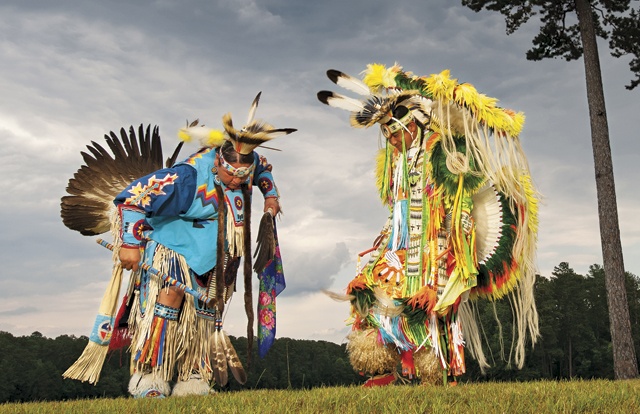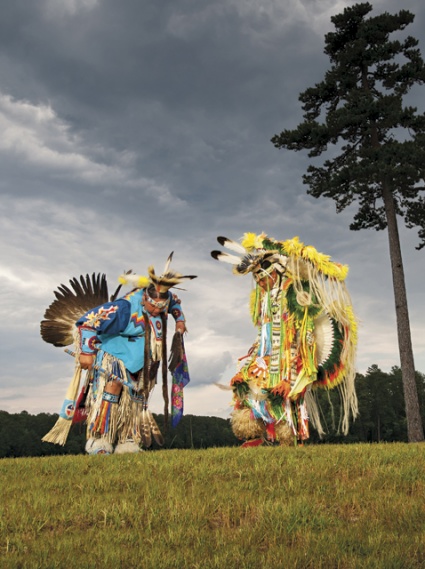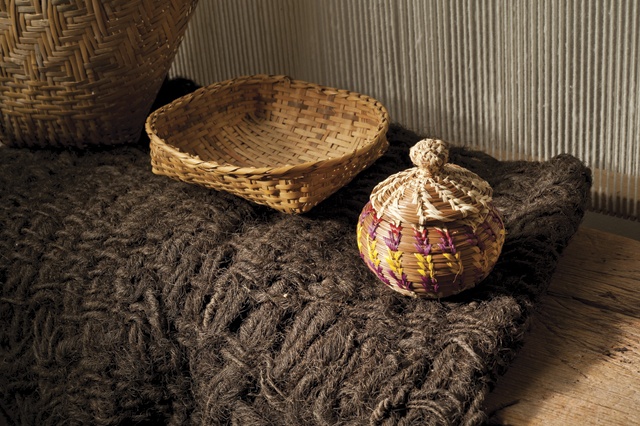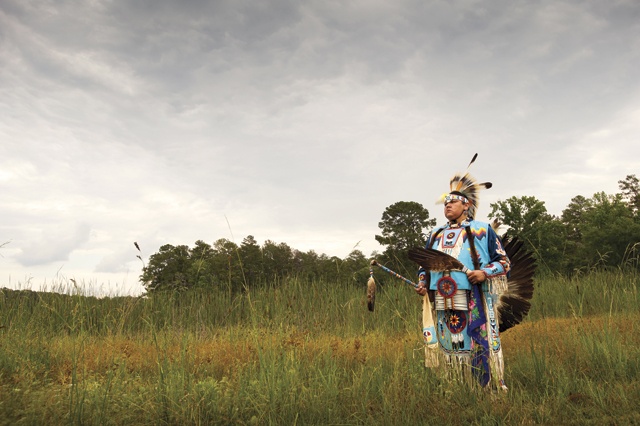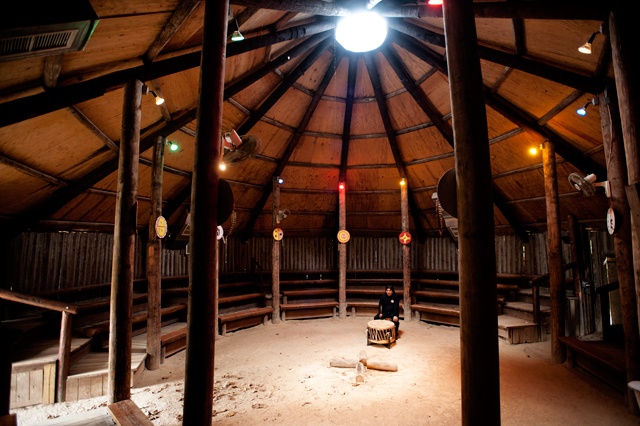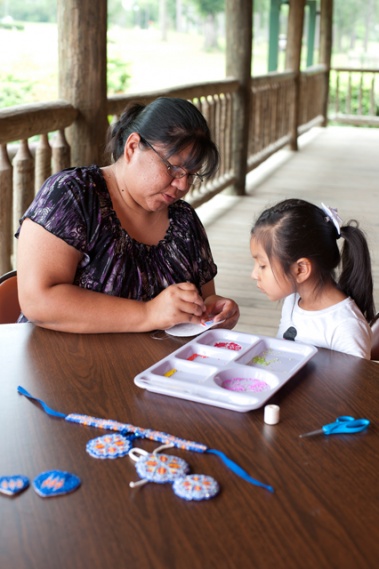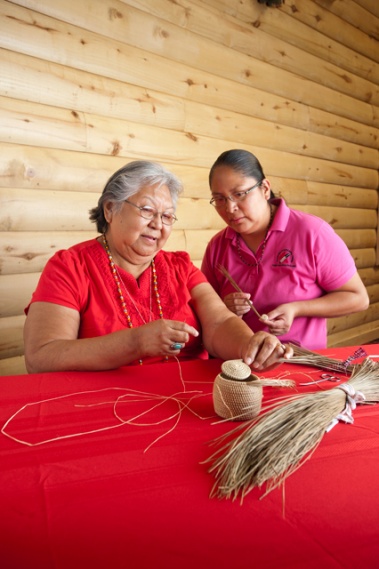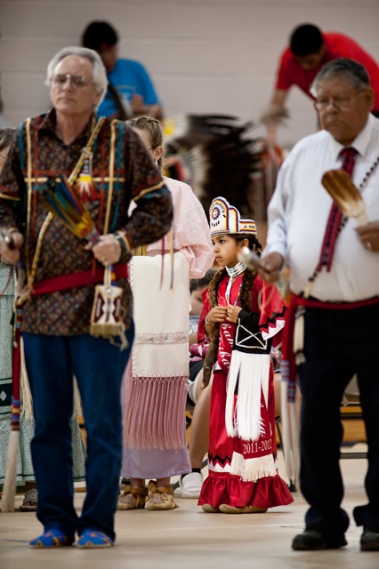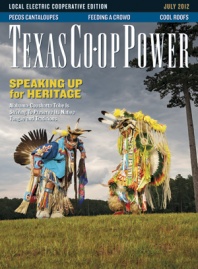Nita!” Ellison Poncho, a 9-year-old Alabama-Coushatta boy whose sunbeam smile could melt an iceberg, belts out the Alabama word for “bear” with ease. He falters over the word for spider, the last of his winning bingo row he’ll need to confirm for the Language Bingo callers. “I’m afraid I won’t say it right,” he whispers to partner Donnis Battise, a retired transportation planner for the tribe who’s fluent in Alabama, his native tongue.
“C’mon, you can speak Indian—just say it: hanchokfala,” says Battise, kindly but firmly. “Um, han…chokfala!” shouts Ellison, beaming as everyone claps and bingo prize bearer Tobine Alec heads his way.
The atmosphere this chilly January evening at the monthly Language Bingo game is ripe with hope. Multiple generations are gathered in the warmth of the majestic, burnished pine log Special Events Center—great-grandparents, grandparents, parents, aunts and uncles partnered with language beginners, coaxing and coaching, word by word, to save their Native American tribe’s disappearing language. Language Bingo is just one way the tribe is trying to preserve the heritage that’s persevered since the Alabamas and Coushattas—then two separate tribes—began departing their ancestral home, what now is Alabama, in around 1763.
The Alabamas and Coushattas, who were first documented by Spanish explorer Hernando de Soto in the 1540s, have long been linked: The two tribes followed similar routes west, and both started arriving in East Texas’ Big Thicket in the 1780s. Their languages both trace back to the North American Muskhogean tribe, and the tribes have intermarried throughout their history.
Today, about 500 tribe members live on the Alabama-Coushatta reservation, roughly 60 miles east of Huntsville and served by Sam Houston Electric Cooperative. Another 600 members live in the vicinity and elsewhere around the U.S. The Piney Woods reservation is scattered with modest brick homes tucked into the dense forest. Here, the federally recognized tribe is the biggest employer—as a sovereign nation, it administers everything from police to parks and operates the Lake Tombigbee campground just down the lane from the tribe headquarters. While mineral rights bring in small but steady oil and gas revenues, tribal leaders say it is a challenge to find jobs beyond the few local businesses, such as timber companies.
But the tribe enjoys at least one strong asset—an unflagging sense of caring community. Everyone knows everyone here, and they’ll pitch in instantly when a member’s in need. It’s evident in the way a wailing child can approach unrelated tribal members and get a helping hand and a hug.
Yet can this sturdy community, along with its ancient culture, endure in the face of trying economic times and the pull of popular culture that lures the young? The Alabama-Coushatta are giving it their best shot to save an irreplaceable part of our beautiful Texas mosaic.
Powwow Power
To ensure the continuation of some of their most significant cultural traditions, the Alabama-Coushatta recognize they need to reach their children. In addition to Language Bingo, the annual Children’s Powwow, which is open to the public, is a powerful tool for sustaining the ancient ways.
Held each year inside the Alabama-Coushatta Multi-Purpose Center, just up the road from the Special Events Center, the Children’s Powwow is a feast for the senses. Children and teens stroll about on a Saturday in January with an air of regal pride. And with good reason: All day today and into the night, kids are in the limelight. Resplendent in their elaborate regalia—a visual extravaganza of intricate beadwork, huge feather bustles, bone breastplates and garments festooned with silver “jingles”—the young will dance before all, and the littlest ones will be presented for their first time on the dance floor.
The steady, deep bass heartbeat from the huge drums seeps bone-deep in a common rhythm that unites all gathered. Listen to the fluid first language spoken by the elders as part of the powwow proceedings. And talk to folks like Delbert Johnson, a tall, quiet-spoken man who plays and sings in the Alabama-Coushatta drumming group, the A-C Woodland Singers. Like others striving to bring back customs nearly annihilated by assimilation efforts throughout the centuries, Johnson saw where the future was headed and knew he’d have to fight to keep his heritage alive.
“I remember being at a powwow in Oklahoma watching a couple of boys who really wanted to dance, but they had no idea how,” says Johnson, 45, who grew up speaking Alabama (it and the Coushatta language are very similar) with his grandfather and picking up dance steps from his uncles. “That touched my heart—I felt bad that their parents didn’t know how to teach them how to dance. That was the same year my older niece, Camille, was born, and I wanted to make sure that she and any other child who wanted to could learn and perform.”
The Children’s Powwow was launched in 1996. “I want the children’s powwows to always be free for the kids and open to any visitors,” says Johnson, who manages the powwow on top of full-time tribal custodial work. “I want it to be there as a fun alternative for kids, because I know there are a lot of opportunities for them to turn away from the culture and get involved in drinking, drugs and getting in trouble.”
At this year’s Children’s Powwow, more than 60 youngsters, toddlers to teens, traveled from Oklahoma, Kansas, New Mexico and Texas to perform dances from the Southern Plains Indian tradition, which includes Alabama-Coushatta. They mingled, walking about in a dazzling display of different regalia. Johnson watched as that niece, Camille, now a tall, beautiful 16-year-old, danced the swaying Southern Cloth Dance along with her own 5-year-old niece, Raegan.
Bead Dazzle
Johnson’s sister and Raegan’s proud mom, Heather Battise, beads the intricate crowns, breastplates, necklaces and earrings the girls wear that day (there may be three regalia switches over the day’s dances) and other performance days. “I do this after work—I’ve got a full-time job,” says Heather, an accounting technician for the tribe. She explains the many techniques and stitches involved in her stunning work; making something like a crown takes her a month.
Keeping the cultural strand as strong as her beading thread is important to Heather and her husband, Patrick. “I spoke Alabama until I got to kindergarten, and all my friends spoke English, so I did, too,” she says. “I make sure to speak Alabama to Raegan so she can understand it, and she can speak some, too.”
Heather’s parents, Herbert Johnson Sr., 70, and Deloris, 67, remember well the times when Indian ways nearly disappeared. “We didn’t have anything like a Children’s Powwow when we were young,” says Deloris as they watch their grandchildren dance. She made Heather’s first crown when she started dancing at age 7 and taught her the beading lore that Heather says she’ll teach Raegan. Deloris continues to sew all the ornate dance dresses for her grandchildren.
Across the powwow floor, the extended family of Jack Battise Sr. and his wife, Lawrine, are gathered. Jack, at 84 the tribe’s sole remaining World War II veteran, is already out on the dance floor. “I’ve been dancing since 1936,” he says, a broad smile lighting a still-smooth face and sculpted cheekbones. “I can barely move these days, but I can’t stop dancing.”
The Battises’ daughter Nita, a tribal council member, chairs the cultural committee; daughter Stephanie Williams is the tribal administrator. Son Garrett, a civil engineer, has come up from Houston to dance with his father. Stephanie’s daughter, Traci Thompson, and husband Brent have brought daughter Ke’Tanah, who is already a practiced dancer at 6. Her baby sister Layla sleeps through all the powwow hullabaloo on a blanket on the floor.
“Carrying on tribal traditions seems natural to us,” says Traci, who grew up speaking Koasati, the Coushatta language. “It’s just what we do.”
Weaving Tradition
A visitor arriving at the tidy brick home of Joyce Poncho and her husband, Robert, will have no doubt about which of the 12 matrilineal Alabama-Coushatta clans the two belong to—turkey (Joyce’s clan) and beaver (Robert’s clan) figurines and ornaments abound both indoors and throughout the yard. Joyce, a warm 72-year-old with a charmingly girlish giggle, has assembled a selection of her baskets this morning along with some made by her sisters and mother.
“I’ve made baskets all my life, and I work on them every day,” Joyce says, explaining how she’ll coil small bunches of the foot-long pine needles in circles, binding the growing rounds with thin raffia palm thread. The artistry that made Joyce a cultural ambassador who has been showcased for years at the Texas Folklife Festival and Smithsonian Folklife Festival is amply evident. She conjures animal baskets with ingenious details, using pine cone “petals” to make owl or turkey feathers and sewing on tiny pine needle nubs to make alligator claws.
“I love to teach,” Joyce says, recalling the many tribal members, young and old, male and female, who’ve learned from her. She glows as she recalls how her neophyte students—from teens to middle-agers—from her last class earned honors at the recent basket-making competition at the tribe’s annual Alabama-Coushatta Cultural Celebration Week, an event for tribal members and their guests.
But getting others to carry on the tribe’s basketry tradition isn’t always easy. “Everyone is in such a hurry these days, and sometimes they don’t have the patience to keep working on a basket,” she sighs. She has the time—and decades of skill building—to create a small basket in a few days. She reminds her beginners that baskets can grow slowly over busy times.
‘We Have So Much to Pass On’
Bryant Celestine, 37, knows well the challenge of shepherding cultural preservation amid the busyness that pressures families here and everywhere. As the tribe’s historical preservation officer, Celestine is surrounded by tribal treasure at his office: baskets made from pine needles and split river cane, kapuche rackets for lacrosse-style stickball games, hollowed hickory logs made into mortars for pounding corn to make sofkey, the much-loved, thick Alabama-Coushatta corn soup. Among the relics, he carefully unfolds a blanket woven from Spanish moss, its soft, deep brown texture a result of a weeks-long process of gathering, cleaning, spinning and weaving long moss strands gathered from local live oaks.
“We have so much to pass on,” he says.
Pine-needle basketry is the practice that’s remained strongest of the Alabama-Coushatta traditions. Interest in different cultural areas is keen among tribal members, Celestine says, but adds that it’s hard for members to find the time for classes beyond the daily pressures of jobs and family. “It was easier in the old days, when people would get together in the evenings and tell the stories over and over,” he notes.
However, Celestine and others in the tribe have come up with an array of savvy tactics to make old customs a part of young lives. He is working on a language computer game and trades expertise with other tribes experimenting with everything from language smartphone apps to board games. Inside tribal member homes, parents use the time-honored trick of simply speaking in the mother tongue instead of English.
Rashyal Sylestine was raised on the reservation with a non-native mom and an Alabama-fluent dad who refused to share his language because he wanted his kids to fit in the English-speaking world. “A lot of parents did that, and I know my dad was just trying to help us,” says Sylestine, who works in the tribal finance office. “But I wish he would have taught us how to speak.” Now she’s learning the language from her uncles and using it with her three young children.
Sharon Miller, the tribe’s public relations head, sees the cultural continuity quest as going beyond reservation borders. “I love to bring along a few folks and give cultural presentations for schools or groups,” she says. “I want people to get to know us beyond any stereotypes.” Chuckling, she notes that sometimes schoolchildren ask her “Where’s the Indian lady?” when she arrives sans the expected feathers and moccasins, looking instead like someone’s favorite aunt wearing jeans and a shirt and talking with a soft Texas twang.
With the help of their supporters, their people and an indomitable will to survive, preservation can happen, says Celestine. “Our people have always been challenged,” he says. “But because of everyone’s efforts, we’re creating the opportunity for the next generation to thrive and carry on our wisdom and ways.”
——————–
Freelance writer Helen Cordes lives in Georgetown.
For more information about tribal events and general information, visit the tribe’s website or call (936) 563-1100. Visitors may stay at the Lake Tombigbee cabins and campground, and find baskets, beadwork and other artisan work at the A-C One Stop Ischoopa (Alabama for “store”) near the reservation entrance.
